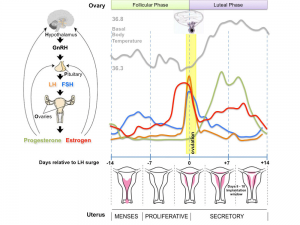Reproductive Cycles
| Embryology - 4 May 2024 |
|---|
| Google Translate - select your language from the list shown below (this will open a new external page) |
|
العربية | català | 中文 | 中國傳統的 | français | Deutsche | עִברִית | हिंदी | bahasa Indonesia | italiano | 日本語 | 한국어 | မြန်မာ | Pilipino | Polskie | português | ਪੰਜਾਬੀ ਦੇ | Română | русский | Español | Swahili | Svensk | ไทย | Türkçe | اردو | ייִדיש | Tiếng Việt These external translations are automated and may not be accurate. (More? About Translations) |
Introduction
Sexual reproduction in most species is regulated by regular endocrine changes, or cycles, in the female. These cycles begin postnatally, function for variable times and can then decrease or cease entirely. There are a number of different species-specific female hormonal cycles which can regulate reproduction.
Menstrual Cycle
Human reproduction is regulated in females the menstrual cycle, a regular cyclic hormonal change which coordinate changes in the ovary and internal reproductive tract.
This cycle commences at puberty and ends at menopause.
- Links: menstrual cycle | ovary | uterus | puberty
Estrous Cycle
The estrous cycle (British spelling, oestrous) is the main reproductive cycle of females of other non-primate species vertebrates.
For example: rats, mice, horses, pigs all have this form of reproductive cycle.
- Links: estrous cycle | mouse estrous cycle
There are also a variety of different estrous forms:
- Polyestrous Animals - Estrous cycles throughout the year (cattle, pigs, mouse, rat).
- Seasonally Polyestrous Animals - Animals that have multiple estrous cycles only during certain periods of the year (horses, sheep, goats, deer, cats).
- Monestrous Animals - Animals that have one estrous cycle per year (dogs, wolves, foxes, and bear)
External Links
External Links Notice - The dynamic nature of the internet may mean that some of these listed links may no longer function. If the link no longer works search the web with the link text or name. Links to any external commercial sites are provided for information purposes only and should never be considered an endorsement. UNSW Embryology is provided as an educational resource with no clinical information or commercial affiliation.
- Rob Gilchrist Lecture - From mono-ovulation to poly-ovulation – oocyte regulation of folliculogenesis (Advances in reproductive biology) January 2016 Lisbon, Portugal.
Glossary Links
- Glossary: A | B | C | D | E | F | G | H | I | J | K | L | M | N | O | P | Q | R | S | T | U | V | W | X | Y | Z | Numbers | Symbols | Term Link
Cite this page: Hill, M.A. (2024, May 4) Embryology Reproductive Cycles. Retrieved from https://embryology.med.unsw.edu.au/embryology/index.php/Reproductive_Cycles
- © Dr Mark Hill 2024, UNSW Embryology ISBN: 978 0 7334 2609 4 - UNSW CRICOS Provider Code No. 00098G


